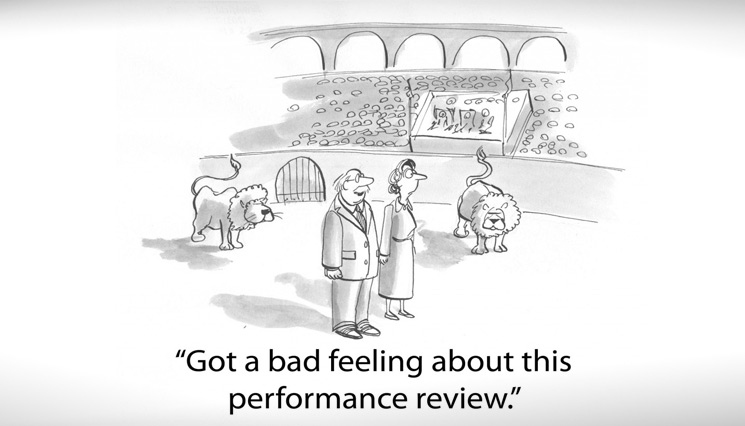Like the cartoon, most people don’t look forward to performance reviews. In fact, in the hundreds of companies we’ve studied, and the thousands of employees we’ve surveyed and with whom we’ve spoken, easily over 60% of them (the review givers and review receivers, alike) express the review process and experience in their organization misses the mark.
We hear things like:
• “I fill out a form, get a score, and never hear anything about it again.”
• “I have to spend 3 hours preparing for each review. Then, another hour doing the review. Then, another hour following our internal process filing the documents. I’ve got 7 direct reports. I lose almost a full week!”
• “I don’t get any feedback that is useful to me. I spend a bunch of time cataloguing all of my accomplishments, so I can justify what I think I deserve in a raise, and then we see hardly any increase, if we see one at all. It seems pointless.”
With the above sentiments coming from the workplace, is it any surprise that 70% of the workforce continues to be disengaged? Here are a few of the elements Gallup explores when determining the disengagement levels in organizations:
• There is someone at work who encourages my development
• In the last 6 months, someone has talked to me about my progress
• My supervisor, or someone at work, seems to care about me as a person
For these (and 9 other) very straightforward points about engagement, 70% do not answer in the affirmative.
The severity of this issue seems pretty clear to us: In over six of 10 cases, neither employee nor supervisor is highly engaged in the critical process of performance reviews and feedback. In over seven of 10 cases, employees (which includes managers and executives) are disengaged, and of the seven, over 20% of them are actively trying to do harm to the organization. Staggering. Unacceptable. We should be ashamed.
We can do better. You can do better. The good news is we are going to give you a blueprint to get started on the path to better.
The overarching principles to success when it comes to creating a passionate, highly engaged company include:
Create a clear and compelling vision of the future. Yes, creating and executing an effective performance cycle starts with vision. Without clarity, it is tough for people to get inspired by, or committed to a common cause (think about Tom’s, or Zappos, or Warby Parker. Employees and customers alike rally around and behind their vision).
Make the vision come to life – every day! Having a vision doesn’t move the needle at all if you don’t make it part of everyday life in your organization. This includes connecting it to role descriptions, making it part of team meetings, including it in 1:1s (what did you do this week/month/quarter that helped us get closer to our vision?). Highlight team members who exemplify the attitude and behaviors needed for your organization to consistently win.
Make performance a regular dialogue, not an annual event. If you want your team to know you are serious about performance, contribution, learning, development, and growth, then show it. In a robust system of planning and engagement, regular 1:1s (weekly or every other week are solid cadences) and team meetings are part of the fabric of the organization. In these sessions, part of the dialogue should be about how individuals are performing against their goals (and the goals should link back to the organization’s big picture goals and strategies), what they are learning along the way, where they are having successes, where barriers exist, and where they need help (needing help is not about being a victim. Top performers often figure out ways to get past barriers on their own. As leaders, we want to understand how, so we can replicate this across the workforce). Performance reviews (which we recommend occurring semi-annually), then become more summative with a very brief look back, and become more about looking forward to what the team member will achieve in the next period of time, and how she will hit those goals.
Make performance conversations just that. In performance related conversations, keep the focus on the individual’s performance, not on the performer herself. This is a small and critical distinction. It isn’t about who they are, but rather about how they are showing up, and how that connects to what the organization values most in the given role. That is the focus.
Put in the damn work! Too often, we hear managers and employees say how busy there are, like it is some badge of courage or honor. Guess what? Everyone is busy. You aren’t special in that way. The question is – are you and your people serious about high performance? If so, dedicate the time to development – as an individual, colleague, and as a leader. After all, if you don’t care enough about your own development to make it a priority and regular topic of discussion, why should anyone else? As a leader, if you don’t make your people’s development and progression part of a regular dialogue, why should they commit themselves to you, your team, and your organization’s cause? (Remember the research that shows that employees quit a boss, not a company. If your people aren’t engaged, consider what you are doing to change that, as opposed to pointing the finger at them, only).
Join us in being part of the movement in creating a workforce that is 70% engaged, as opposed to the other way around.








